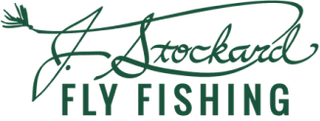Guest Blogger: J. Stockard Pro Jeff Rowley. Follow Jeff on Instagram.
The original Chernobyl Ant was developed in the early 1990s by Utah fly tyer Allen Woolley. It quickly gained fame for its buoyancy and effectiveness during terrestrial seasons.
This variant draws on modern materials and tying tips from Tim Flagler, offering a clean, high-floating profile with vibrant contrast and movement. It’s an excellent choice when big bugs—hoppers, beetles, ants—are crashing onto the surface.
Chernobyl Ant Recipe
Hook: Ahrex NS118, size 6
Thread: Semperfli Classic Waxed 8/0, Pale Olive
Tail: SemperFlash (4 strands)
Body:
Semperfli Double Decker Foam, Black/Orange
Semperfli Kapok Dubbing, Black & Rust
Semperfli Grizzly Flutter Legs
Semperfli PolyYarn, White
Other: River Road Foam Grasshopper Body Cutter
Adhesive : Zap-a-Gap or similar
Step 1: Begin the Base

Secure the hook in your vise. Start your thread approximately 1mm behind the hook eye and lay a smooth thread base down the shank to just above the barb.
Tie in four strands of SemperFlash by folding them around the thread and securing them at the rear of the hook with firm wraps.
Step 2: Attach the Foam

Return your thread to the starting point. Cut a thin (1mm) strip of black/orange foam and tie it in at the front.
Spiral-wrap the foam back toward the tail using a touch of glue (Zap-a-Gap) on the shank for extra hold. Secure the foam with several tight wraps at the back of the hook, then trim off the excess.
Step 3: Add Dubbing & Body

Dub a small amount (~3mm) of black Kapok onto the thread.
Position the pre-cut foam body on top, pinch it into place, and secure it with progressively tighter wraps—firm enough to hold but not so tight that it cuts the foam.
Step 4: Add Legs & Wing Post

Loop in grizzly flutter legs on both sides. Tie in a small bundle of white PolyYarn at the mid-point of the body to act as a wing post for visibility.
Add more black Kapok dubbing behind the post. Pull the PolyYarn back and continue dubbing in front of it, making sure the legs remain properly positioned.
Advance dubbing along the shank—still in black—up to the ¾ point. Switch to rust Kapok dubbing and cover the remainder of the shank, stopping about 1mm behind the eye.
Step 5: Finish the Head Segment

Pull the foam forward and tie it down at the front, leaving the 1mm gap behind the eye.
Repeat the process: add another set of legs, another small PolyYarn post, and dub the front section with rust Kapok.
Whip finish neatly under the foam, securing everything in the space behind the eye.




2 comments
Steve Kautz
More fly recipes to choose from at anytime
Dennis Brown
Is it possible to provide a video on your website for the flies of the month? Or any other favorite flies.
Thanks